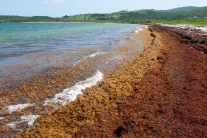Hypoxia, Climate Warming, and Eutrophication in the Northern Gulf of Mexico
Fri, 12/15/2023 - 9:12am
A beach on Saint Martin in the Caribbean (east of Puerto Rico) covered in Sargassum seaweed. (Image credit: NOAA AOML)
The National Oceanic and Atmospheric Administration (NOAA) recently announced $20.1 million in funding for harmful algal bloom (HAB) and hypoxia research projects and monitoring activities throughout U.S. coastal and Great Lakes waters.
Bingqing Liu of our School of Geosciences will be working with investigators at Louisiana State University and Princeton University on a major study of the roles of harmful algal blooms, warming, and extreme weather events in the Northern Gulf of Mexico. Liu is leading the UL Lafayette component of the project. Her duties include developing the biogeochemistry model, conducting large-scale fieldwork in the northern Gulf of Mexico, collecting field hyperspectral measurements, and creating remote sensing products to validate and calibrate the biogeochemistry model.
This project is funded by the NCCOS Competitive Research Program (CRP) in NOAA's National Ocean Service. This project is being led by Louisiana State University with a total budget of $1.56 million, and a grant allocation of $210,000 to UL Lafayette.
The project title is "Biological Vulnerability to Hypoxia from Climate Warming and Eutrophication in the Northern Gulf of Mexico." The abstract follows.
The hypoxic zone in the northern Gulf of Mexico (NGOM), triggered by eutrophication, continues to have widespread negative impacts on the marine ecosystem and species. The formation, evolution, and ecological impact of the hypoxic zone under current conditions are relatively well studied. However, the hypoxic zone under future conditions with the combined effect of climate warming, ocean deoxygenation, and eutrophication remains to be explored. Dissolved oxygen concentration of less than 2 mg/L is usually used to define environmental hypoxia but the impact of hypoxic stress on marine animals, i.e., physiological hypoxia, is controlled by both dissolved oxygen concentration and animal metabolic rate modulated by temperature. To better understand the impact of hypoxia on marine organisms of importance, this project will characterize the NGOM hypoxic zone under climate warming and eutrophication, develop and calibrate an ecophysiological framework for commercially and ecologically important species in the NGOM, and apply it to study temperature-dependent habitat shifts and contraction and body size shrink for those species in NGOM in the next three decades by mid-21st century. Finally, the project will engage coastal zone resource managers and policymakers to ensure the transition of research products to management.

